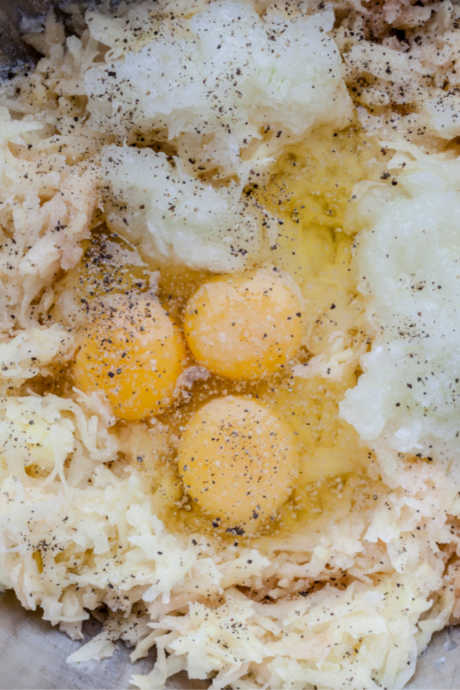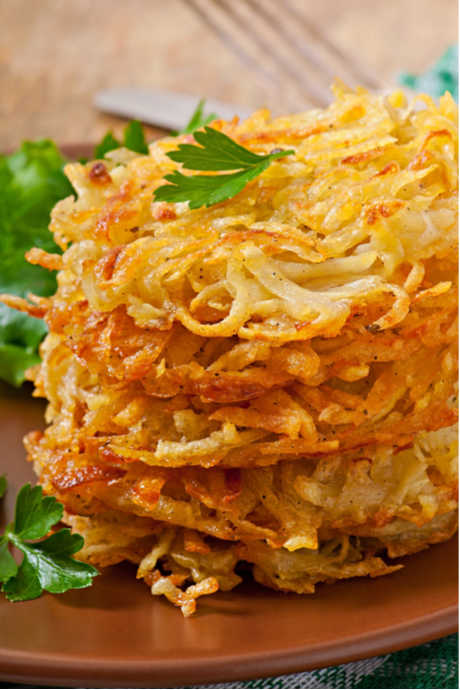For the Love of Latkes
Posted by Julie on Dec 13th 2019
This year, the first night of Hanukkah falls on December 22. One of the most beloved traditional foods eaten over the eight nights of Hanukkah is latkes. Like other traditional foods eaten on Jewish holidays, latkes are symbolic. They are also pan-fried in oil and a delicious treat no matter how you season or top them. In this post, we’ll explore why latkes are eaten on Hanukkah, along with tips and tricks for making them yourself. We’ll also include a few recipes that ought to tempt you into giving latkes a try.
Why Latkes?
Apart from the fact that fried potatoes are tasty any time of year, latkes are a Hanukkah tradition for a few key reasons. The oil used for frying latkes represents the oil that lasted eight days in the Temple menorah in Jerusalem after the Maccabees defeated the Assyrians. Other fried foods like sufganiyot (which are similar to jelly doughnuts) and dairy foods like cheese and sour cream are also mainstays of Hanukkah meals.
Latkes are usually topped with applesauce or sour cream. We love this exchange on Reform Judaism that argues for each option, and we can see the points for both sides. Light, sweet applesauce complements the heaviness of latkes, even when you fry them crisp. It also ensures your meal is kosher, since the oil used to fry latkes often contains a smidge of schmaltz (rendered chicken fat) for added flavor.

On the other hand, sour cream may be heavy and fatty, but it tastes heavenly spread on fried potatoes. It’s also symbolic of the dairy foods that helped Judith triumph over an enemy general during the war between the Maccabees and the Assyrians. Whether you choose applesauce or sour cream, or you eat your latkes plain, Chabad.org implores you not to dip them in ketchup.
You can make latkes with potatoes, or you can substitute other vegetables like carrots or zucchini. Potatoes are the traditional choice because of their wide availability and relative affordability, even centuries ago.
The Basics of Latkes
Latke recipes abound on the internet, but the most helpful resource we found was Tori Avey’s post on how to make better latkes. More than a mere list of ingredients and instructions, Tori goes into detail about how to prep your potatoes, test the oil temperature, and cool your finished latkes. We encourage you to read her post, but we’ll summarize a few of the key tips below.
You can shred your potatoes however you prefer, as fine or as coarse as you like. You can even use frozen hash browns. But if you use fresh potatoes, soak them in water. If you use frozen potatoes, thaw them completely. Then dry them as thoroughly as possible. Here’s why: Soaking them helps remove the starch so they will be more crispy. Dry potatoes will also be more crispy.

But don’t wash that potato starch down the drain. Conserve as much of it as you can, then add it to your soaked, dried potatoes to help them adhere to one another. Tori also advises buying packaged potato starch to add to your latkes as a binder.
Heat oil in a heavy skillet (we always favor cast iron for this purpose) and use a cooking thermometer to check the temperature. Fry a test latke by itself before loading up the pan with a half-dozen latkes. Tori suggests 2-3 minutes per side, if the oil is the right temperature. Then transfer your latkes to a draining rack set over paper towels. The paper towels will catch any excess oil, and the air circulation around the rack will keep your latkes crispy.
Finally, we echo Tori’s recommendation to steer clear of olive oil and schmaltz for frying your latkes. Olive oil burns easily, and schmaltz by itself is simply too hard on your arteries. However, we’re all in favor of adding a small amount of schmaltz to your cooking oil.
Latke Recipes to Try
If you’re brand new to making latkes, start with the classic potato latkes from Tori Avey, or try her recipe that swaps panko breadcrumbs for traditional matzo meal. You can keep progressing down her list of latke recipes, trying the ones that look good to you.

When you feel as if you’ve mastered basic latkes, you can challenge yourself with these creative combinations from What Jew Wanna Eat. First, check out this Latke-Stuffed Challah. This epic loaf consists of three braided strands. The first strand contains chunks of latkes. The second strand holds a diced Granny Smith apple mixed with sugar and cinnamon. The third strand is bursting with sour cream filling. This recipe solves the dilemma of choosing between applesauce and sour cream! We’re tempted to turn this loaf into French toast.
Next, get ready for dessert with S’mores Latkes. If you’re a fan of sweet and salty combinations, this recipe will be a hit. You’ll shred the potatoes as usual, but leave out the onions. Instead, add graham cracker crumbs, salt, sugar, and egg. Instead of forming patties, drop a scoop of batter into the hot oil and flatten it. Fry both sides and drain on a rack, just as you would with traditional latkes. But after you’ve finished frying them all, return them to the frying pan (after draining the oil, of course) or a baking sheet, and top each one with a square of chocolate and a marshmallow. Delicious!

